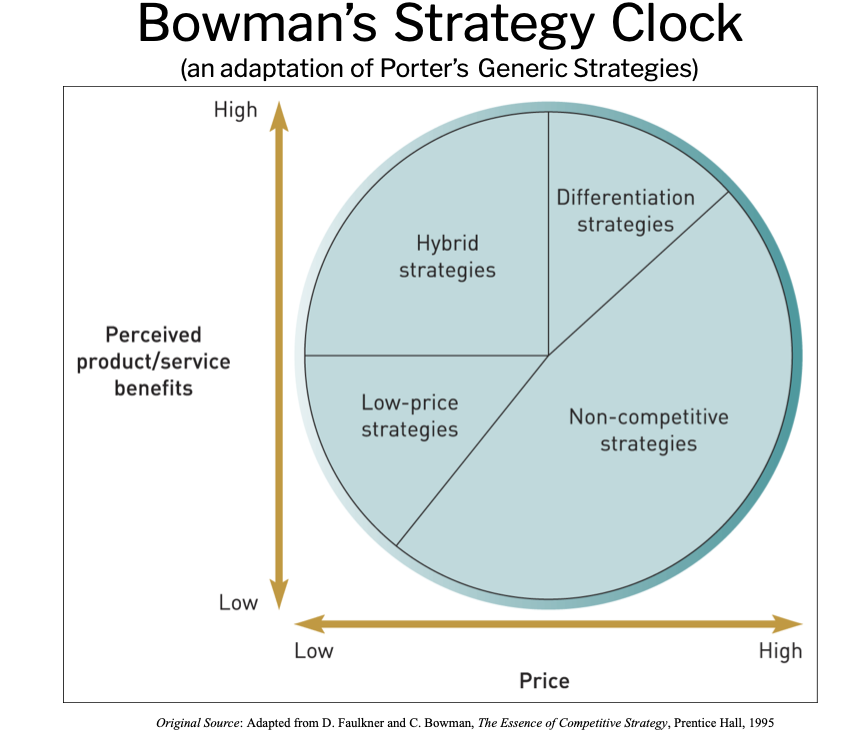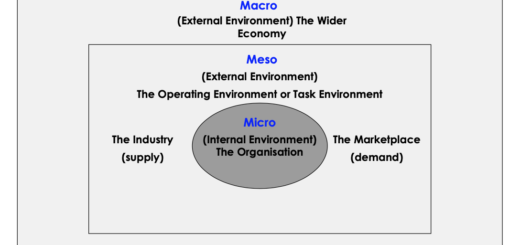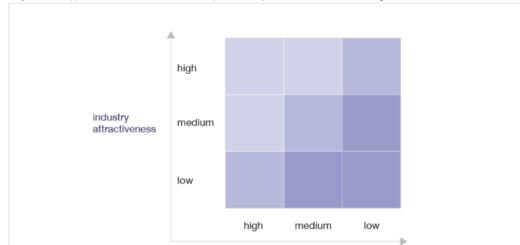Bowman’s Strategy Clock
Bowman’s Strategy Clock is an adaptation of Porter’s generic strategies that offers a more nuanced and detailed framework for developing competitive strategies. It was developed by Cliff Bowman, a British strategy expert, and is based on eight possible positions that a company can adopt to achieve and sustain competitive advantage. The positions are arranged in a clock-like diagram, with each position representing a different combination of price and value.

Strategy Clock – Low Price: Low price combined with:
- low perceived product benefits focusing on price-sensitive market segments – a ‘no frills strategy.
- lower price than competitors while offering similar product benefits – aimed at increasing market share
Strategy Clock – Differentiation: Products that offer benefits that differ from those offered by competitors. A range of alternative strategies from:
- differentiation without price premium
- differentiation with price premium
- focused differentiation
Strategy Clock – Hybrid: Seeks to simultaneously achieve differentiation and low price relative to competitors.
Hybrid strategies can be used:
- to enter markets and build position quickly.
- as an aggressive attempt to win market share.
- to build volume sales and gain from mass production.
Strategy Clock – Non-Competitive
- Increased prices without increasing service/product benefits
- In competitive markets, such strategies will be doomed to failure
- Only feasible where there is strategic ‘lock-in’ or a near monopoly position

The eight positions on Bowman’s Strategy Clock are:
- Low Price/Low Value: This position represents a strategy of low cost and low quality. This is usually a defensive strategy adopted by companies that have little competitive advantage and operate in price-sensitive markets.
- Low Price: This position represents a focus on low prices, with acceptable quality. Companies adopt this strategy to capture price-sensitive customers, but it may not be sustainable in the long term as competitors can easily copy the approach.
- Hybrid Low Price: This position combines low prices with a higher level of perceived value. This strategy is adopted by companies that aim to compete on price, but also offer additional benefits such as quality, features, or brand reputation.
- Differentiation: This position focuses on differentiating the company’s products or services from competitors, often through unique features, quality, or branding. This strategy requires investment in product development and marketing but can create a stainable competitive advantage.
- Focused Differentiation: This position is similar to differentiation, but with a focus on serving a narrow market segment. This strategy requires a deep understanding of the needs of the target market and can create strong customer loyalty and higher profit margins.
- Increased Price/Standard Value: This position represents a strategy of charging a premium price for a product or service that is not significantly differentiated. This can be a successful strategy in markets where there is limited competition and customers are willing to pay for a perceived high quality or status.
- High Price/Low Value: This position is a high-risk strategy of charging a premium price for a product or service that is not perceived to be of high quality. This is usually adopted by companies that have a monopoly or a strong brand reputation and can be unsustainable in the long term.
- Low Value: This position is a very high-risk strategy, representing a focus on high prices and low quality. This strategy is usually adopted by companies that have a monopoly or by firms that want to exit a market, as it is not sustainable over the long term.
Overall, Bowman’s Strategy Clock offers a more nuanced and detailed framework for developing competitive strategies, allowing companies to identify and evaluate their position in the market and develop strategies that are tailored to their strengths and the specific needs of their customers.
Bowman’s Strategy Clock; an example
It’s unlikely for a single company to occupy all 8 positions on Bowman’s Strategy Clock simultaneously as the positions are mutually exclusive. However, here is the examples of how a company might be positioned at each of the 8 positions:
Here is an example of a company’s potential positioning on all 8 positions of Bowman’s Strategy Clock:
- Low price/low value: A company that competes on the basis of cost and offers a product or service at a lower price than its competitors but with lower value. An example of such a company is a budget airline that provides no-frills service at a much lower cost than traditional airlines.
- Low price: A company that offers a lower-priced product or service than its competitors but does not compromise on quality. An example of such a company is a discount retailer like Walmart, which offers quality products at a lower price than other retailers.
- Hybrid: A company that offers a differentiated product or service at a mid-range price point. An example of such a company is Toyota, which offers reliable, high-quality cars at a lower price than luxury car brands.
- Differentiation focus: A company that offers a highly differentiated product or service to a niche market. An example of such a company is Lululemon, which offers high-end athletic wear for yoga enthusiasts.
- Focused differentiation: A company that offers a highly differentiated product or service to a narrow target market. An example of such a company is Rolex, which offers luxury watches to a small market segment that values high-end luxury goods.
- Increased price/standard: A company that charges a premium price for a product or service with standard features. An example of such a company is Apple, which charges a premium price for its products due to its strong brand image and innovative design, despite offering features similar to its competitors.
- Increased price/low value-added: A company that charges a premium price for a product or service that offers no significant added value. An example of such a company is an overpriced restaurant that charges a high price for mediocre food.
- Low value added: A company that offers a product or service with low added value at a high price. An example of such a company is a luxury resort that charges a high price for a mediocre experience.





